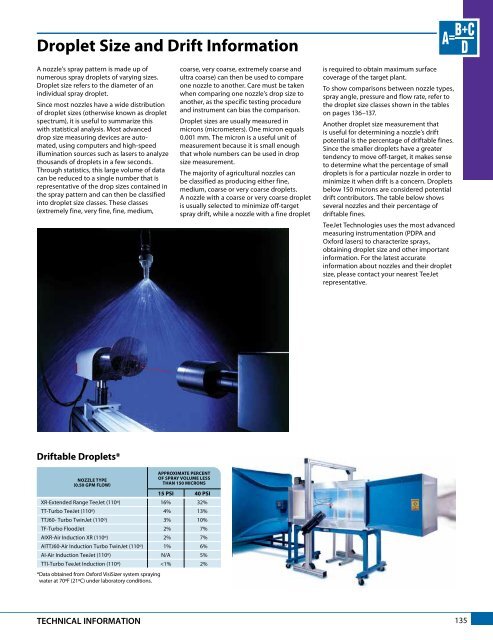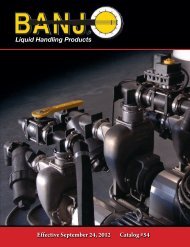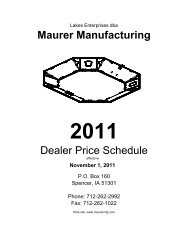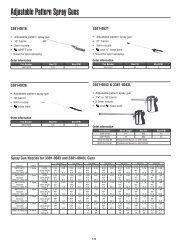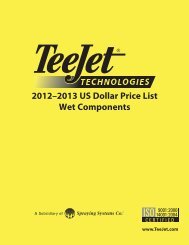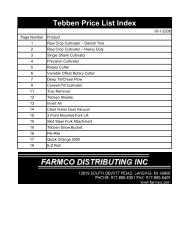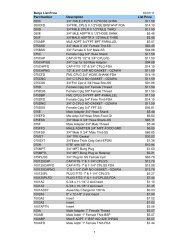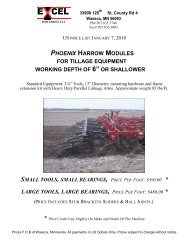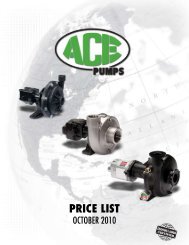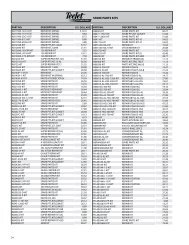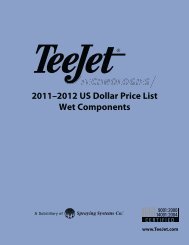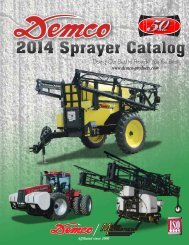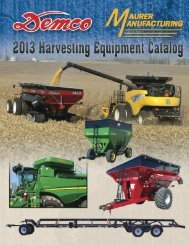Teejet Catalog 51 - Farmco Distributing Inc
Teejet Catalog 51 - Farmco Distributing Inc
Teejet Catalog 51 - Farmco Distributing Inc
You also want an ePaper? Increase the reach of your titles
YUMPU automatically turns print PDFs into web optimized ePapers that Google loves.
Droplet Size and Drift Information<br />
A nozzle’s spray pattern is made up of<br />
numerous spray droplets of varying sizes.<br />
Droplet size refers to the diameter of an<br />
individual spray droplet.<br />
Since most nozzles have a wide distribution<br />
of droplet sizes (otherwise known as droplet<br />
spectrum), it is useful to summarize this<br />
with statistical analysis. Most advanced<br />
drop size measuring devices are automated,<br />
using computers and high-speed<br />
illumina tion sources such as lasers to analyze<br />
thousands of droplets in a few seconds.<br />
Through statistics, this large volume of data<br />
can be reduced to a single number that is<br />
representative of the drop sizes contained in<br />
the spray pattern and can then be classified<br />
into droplet size classes. These classes<br />
(extremely fine, very fine, fine, medium,<br />
coarse, very coarse, extremely coarse and<br />
ultra coarse) can then be used to compare<br />
one nozzle to another. Care must be taken<br />
when comparing one nozzle’s drop size to<br />
another, as the specific testing procedure<br />
and instrument can bias the comparison.<br />
Droplet sizes are usually measured in<br />
microns (micrometers). One micron equals<br />
0.001 mm. The micron is a useful unit of<br />
measurement because it is small enough<br />
that whole numbers can be used in drop<br />
size measurement.<br />
The majority of agricultural nozzles can<br />
be classified as producing either fine,<br />
medium, coarse or very coarse droplets.<br />
A nozzle with a coarse or very coarse droplet<br />
is usually selected to minimize off-target<br />
spray drift, while a nozzle with a fine droplet<br />
is required to obtain maximum surface<br />
coverage of the target plant.<br />
To show comparisons between nozzle types,<br />
spray angle, pressure and flow rate, refer to<br />
the droplet size classes shown in the tables<br />
on pages 136–137.<br />
Another droplet size measurement that<br />
is useful for determining a nozzle’s drift<br />
potential is the percentage of driftable fines.<br />
Since the smaller droplets have a greater<br />
tendency to move off-target, it makes sense<br />
to determine what the percentage of small<br />
droplets is for a particular nozzle in order to<br />
minimize it when drift is a concern. Droplets<br />
below 150 microns are considered potential<br />
drift contributors. The table below shows<br />
several nozzles and their percentage of<br />
driftable fines.<br />
TeeJet Technologies uses the most advanced<br />
measuring instrumentation (PDPA and<br />
Oxford lasers) to characterize sprays,<br />
obtaining droplet size and other important<br />
information. For the latest accurate<br />
information about nozzles and their droplet<br />
size, please contact your nearest TeeJet<br />
representative.<br />
Driftable Droplets*<br />
Nozzle Type<br />
(0.50 GPM Flow)<br />
XR-Extended Range TeeJet (110º)<br />
TT-Turbo TeeJet (110º)<br />
TTJ60- Turbo TwinJet (110º)<br />
TF-Turbo FloodJet<br />
AIXR-Air Induction XR (110º)<br />
AITTJ60-Air Induction Turbo TwinJet (110º)<br />
AI-Air Induction TeeJet (110º)<br />
Approximate Percent<br />
of Spray Volume Less<br />
Than 150 Microns<br />
15 PSI 40 PSI<br />
16% 32%<br />
4% 13%<br />
3% 10%<br />
2% 7%<br />
2% 7%<br />
1% 6%<br />
N/A 5%<br />
TTI-Turbo TeeJet Induction (110º)<br />


